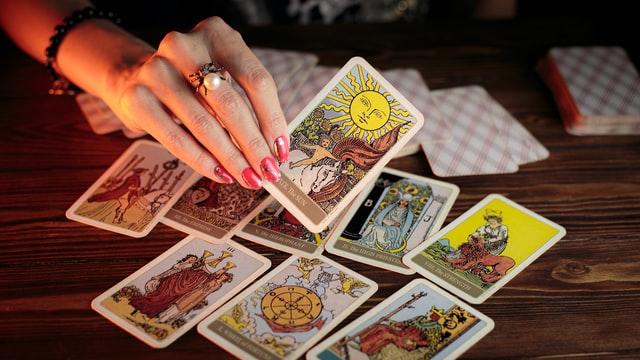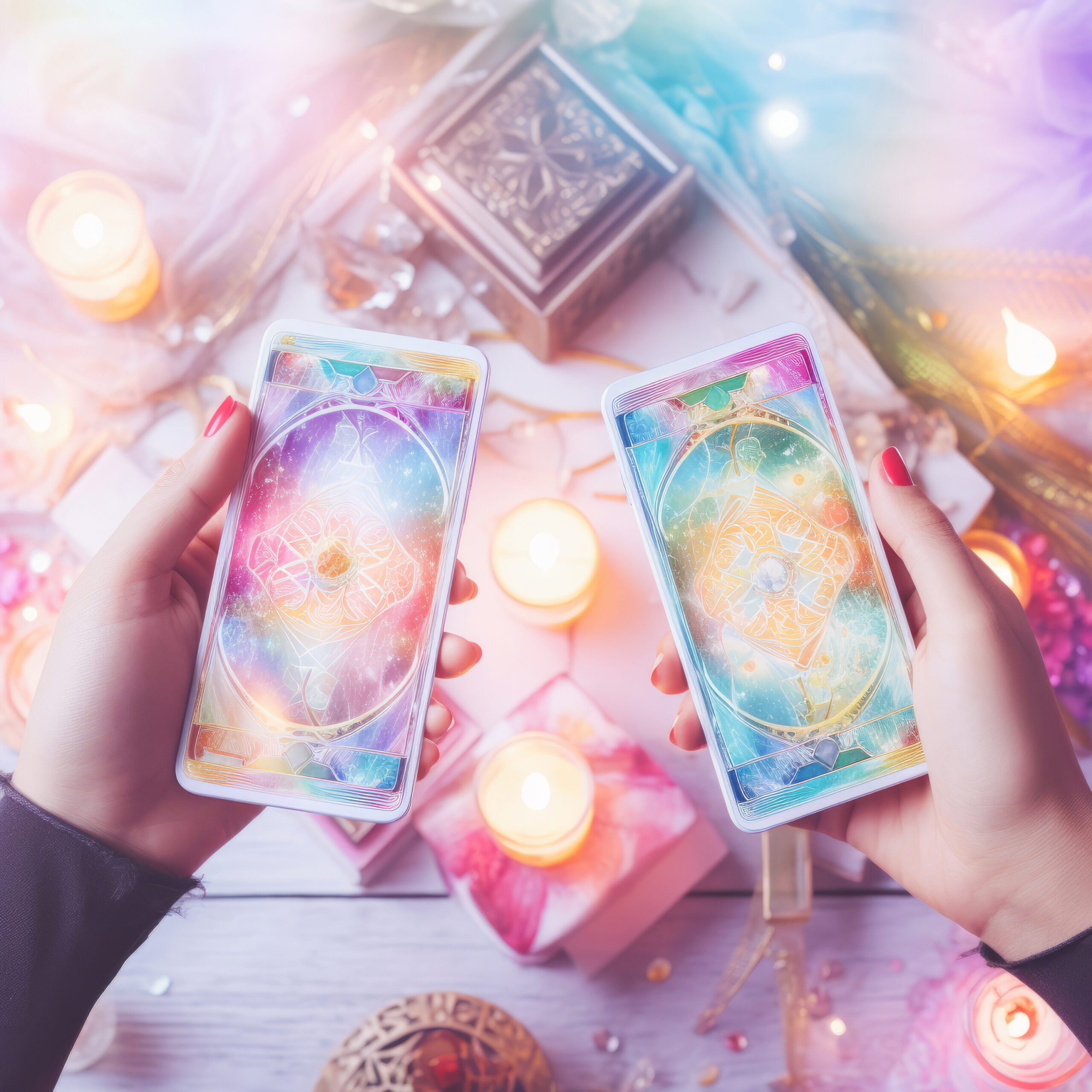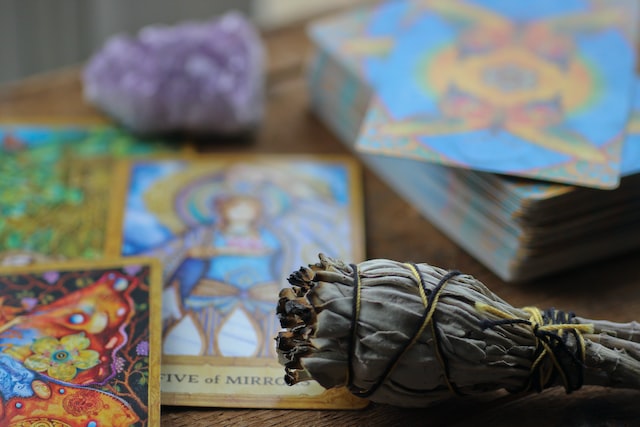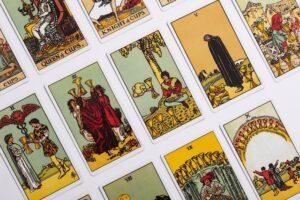Learn to Read Tarot 101
An overview of learning to read the tarot, a brief overview of your new deck and how to create the story that the cards are creating.
Learn to Read the Tarot
When you first receive your deck, regardless of whether you purchased it or it was gifted, take some time to familiarize yourself with it. Even if you’re a seasoned reader, every deck has unique imagery and every author has put their own creativity into the creation of it. Please note: this also applies to Oracle Decks.
Once you’ve had a chance to look at each of the cards, separate the cards into the Major Arcana (the Trumps) and the Minor Arcana (depicts real life experiences).
Major Arcana
In the Major Arcana, the cards are numbered from 0 (The Fool) to XXI (The World). The Major Arcana depicts the journey through life and if you split them into 2 groups of 7, depict the journey from youth into adulthood finishing in aged adult. In the Triple Goddess, these are Maiden, Mother & Crone.
Minor Arcana
In the Minor Arcana, separate the cards into their respective suits. Suits in the tarot are: Wands, Cups, Swords and Pentacles. Each of the suits relates to an element and carries deeper meaning. We will discover these in more detail in a future post.
Symbols are very important in the Tarot. Go through each of the cards again and pay close attention to colors, flowers, animals, clouds, positions of the ‘person’ portrayed etc. Do not judge your perceptions of what stands out to you in each of the cards. Journal your thoughts and things that stand out to you for future review as you learn the deck in more detail. The more you handle and study your cards, the better you will become. Becoming a well versed reader comes from constant dedicated hours of practice.
Introduction to Deck
Structure of the Tarot
There are 78 cards in a traditional tarot deck. They consist of 22 Major Arcana numbered from 0 to 21. There are 56 Minor Arcana consisting of 4 Kings, 4 Queens, 4 Knights, 4 Pages, & 4 Aces. The remainder of the cards, numbered 2 to 10, make up a total of 36 cards.
Major Arcana
Each card in the Major Arcana (MA) is numbered and named. The symbols on each have been used for thousands of years and were the only cards that made up the original Tarot. The Minor Arcana (MiA) wasn’t added until many years later and were added to build and provide more information to readings.

When reading the MA, take note of where and how many of the MA cards appear in your spread (how the cards are displayed for interpretation). They may indicate a new phase of your life, explain the one your in more deeply, or highlight an important person or situation pertaining to your query (what you asked the cards for insight into).
When reading the MA, take note of where and how many of the MA cards appear in your spread (how the cards are displayed for interpretation). They may indicate a new phase of your life, explain the one your in more deeply, or highlight an important person or situation pertaining to your query (what you asked the cards for insight into).
These 22 cards are the highest and most important cards in the deck so spend a little more time discerning how and why they’re showing up in your life.
The Fool
The Fool can be used to identify you (you on your journey and/or phase of life) or event relating to the story of the reading (see below). He is assigned the number 0 and represents innocence and/or encourages us to take a ‘leap of faith’. Due to his not having a number, he’s the leap of faith required to move from one life transition to the next. We will get into much more detail in future posts.

Minor Arcana
The 56 cards of the Minor Arcana are similar to a deck of playing cards. They consist of four suits. The court cards (King, Queen, Knight, Page, Ace) fall into the pattern of the picture cards of the playing deck. The Knight is an extra card.
The Minor cards show aspects of life as people actually live it. In these 4 suits, and more especially in the combinations they form when we lay them out in readings, we find a panorama of experiences, constantly showing us new insights into the wonders of human nature and this magickal world. The Tarot serves those who use the cards primarily for awareness of self and of the world around us.
Court Cards
The 4 suits relate to the regular cards deck as follows: Wands = clubs, Cups = hearts, Swords = spades, and Pentacles = diamonds. The court cards usually represent people. The court cards can also represent a situation that relates to the query or the guidance sought by the sitter (yourself or other person). The court cards are not numbered like the MA but by the number of the individual suits i.e. 2 of pentacles, 5 of wands, etc. The four suits depict the four basic tools of ritual magick.
As it pertains to the elements: Wands = Fire, Cups = Water, Swords = Air, and Pentacles = Earth. If we wish to see the world in terms of five rather than four, then the Major Arcana is the fifth element of Spirit. By setting it apart from the four Minor elements symbolizes the intuition that Spirit somehow exists on a different level from the ordinary world. At the same time, the fact that we mix all five together for readings help us see that in reality Spirit and all the elements of matter constantly work together. As each suits as aligned with an element would represent the zodiacs for that element i.e. Fire = Aries, Leo, Sagittarius.
Other representations also include: Wands = Intuition, Cups = Feeling, Swords = Thinking, and Pentacles = Sensation.
Aces
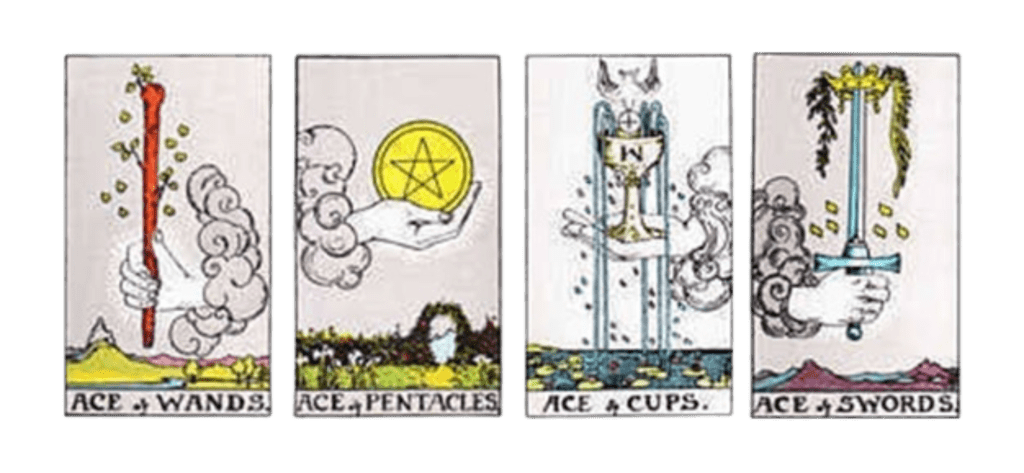
Aces represent the first of the sequence of the ten cards of any suit . They can be used to indicate the seasons: Aces of Wands = Spring, Ace of Cups = Summer, Ace of Swords = Autumn, and Ace of Pentacles = Winter.
Aces also represent receiving from Source/God/Goddess/Divine pertaining to the meaning of that suit.
Reversed Cards
When cards show up upside down it can alter the standard meaning of that card as it pertains to the reading. There are different general opinions on how to read a card that shows up upside down – this is relevant to your perspective. When reading for others, if the card is upside down to you, then it’s considered a reversed card.
Some readers ignore reversed cards completely. They simply turn it right side up and continue with the reading.
Some readers interpret a reversed card and the complete opposite of the standard understanding of that card.
Some readers, myself included, like to consider the meaning diminished to the accepted meaning. When I see a reversed death card, for example, I interpret it as something in your life is either coming to an end soon or you just came out of an upheaval in your life.
Telling the Story
One of the best ways to learn is to focus on one group at a time – MA, Wands, Cups, Swords, Pentacles. Learn the upright meaning before reading and/or deciding how you want to read reverse cards. Remember any resource that describes the meanings of the cards are only being offered as a guide and a starting point to establish the energy of the card and it’s imagery.
Start by doing readings for your own personal questions and pull only 1, 2 maximum, for interpretations. As you gain confidence, start reading more cards per reading or for friends/family who understand that you’re learning.
Shuffle the cards as you consider your question, be specific. When you feel your ready, pull the card(s) and place them face up in front of you. Pay attention to what catches your attention first: color, imagery, energy you feel like excitement or avoidance. Then move to what you know about each card – consult a guide book, trusted website or notes. Then use your intuition to formulate what you believe the cards are trying to tell you. It is recommended to use a journal book to keep track of your readings – review your notes on a regular basis and see if you see patterns like the same cards showing up, a reversed card now showing up right side up or visa versa. This will also assist you in becoming familiar with your deck.
Feel the flow and dynamism of the cards. If you experience difficulties with any particular reading or card, do not give up. Sometimes the combinations may not be simple to interpret or what the cards are showing you may be coming in the near future and elements of the reading may not have presented themselves yet. Sometimes pulling a “clarity” card may help also. It’s fills out the picture the cards are showing you and that next card may tie it together.
Conclusion
As the interpreter, it is important to tell the story that unfolds, being careful to present the highlights and the warnings of the cards in a simple, straightforward manner, keeping in mind the emotional significance of anticipated joy or sorrow.
You read the cards to seek an answer, direction, insight or confirmation. Try not to be general in your question as this will make interpretation harder to discern.
The sitters free-will & choice will always trump the prediction/advice of the Tarot. Keep this in mind when asking or answering questions like predicting the future or timelines. Keep in mind the Tarot does not answer Yes or No but instead attempts to create a story for us to use as a tool to enhance our choices and decisions.
There is no right or wrong way to interpret the Tarot. Trust your intuition and set time aside to get to know the individual cards. And most importantly, have fun.
Check back for the next Learn To Read Tarot posts coming soon!!


